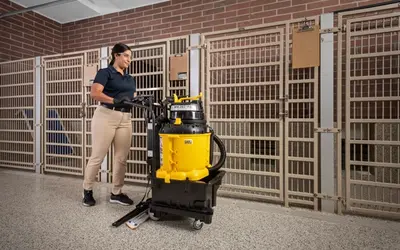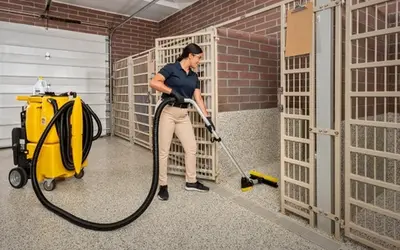Ultimate Guide to Cleaning Chemicals

A janitor’s closet full of cleaning chemicals offers a lot of choice, and a lot of opportunities for confusion. With a different solution for every task, your cleaning staff faces a dilemma. What product is best for floors? Do solutions for restrooms also work in the kitchen? What is pH and why should I care? We developed this blog to answer those questions – your ultimate guide to cleaning chemicals.
Cleaning chemical choice matters. Choosing the wrong cleaning agent may lead to poor results or, worse, damage expensive surfaces and finishes. Even choosing the right cleaning chemical can present a problem if workers do not know how – or how much – to use.
As daunting as it seems, picking the correct cleaning agent does not have to be hard. This guide to cleaning chemicals will break down cleaning chemistry and provide best practices for different products and applications.
Cleaning Products: Know Your Cleaning Chemistry
Cleaning solutions contain a variety of different ingredients designed to break down, capture, and remove soils. The most common are called surface active agents also known as surfactants. These ingredients change the surface tension of water, increasing its spreading and wetting properties.
Cleaning products also include plenty of other chemicals too including sequestering agents, builders, solvents, fragrances, preservatives, and dyes. Most importantly, they also include pH adjusters. These additives tune the product’s pH, allowing it to better capture and remove specific kinds of soils.
Matching Cleaning Agents to the pH Scale
Cleaning agents run from alkaline to neutral to acidic depending on their pH (pH is measured on a scale from 0 to 14). A high pH means the product is alkaline while a low number indicates the product is acidic. Neutral cleaners sit in the middle with a pH of around seven. Finding the right chemical for the right job means choosing the right pH.
Neutral cleaning chemicals are safe for most hard surfaces. These all-purpose cleaners can also be slightly alkaline and still be considered neutral. But take caution as some of these choices contain abrasive agents that can scratch and dull surfaces. Over time these abrasives make surfaces harder to clean as soils settle into the scratches. To avoid this, choose a product without abrasive additives like KaiO™ from Kaivac instead.
Alkaline products have a high pH, think chlorine bleach with a pH of 11 to 13. These products attack protein-based soils, fats, and greasy, oily messes. Because of this, alkaline cleaners like KaiPow™ from Kaivac, work well in industrial settings and commercial kitchens.
Acidic cleaners, such as KaiBlooey™ from Kaivac, remove inorganic stains like mineral deposits, hard water scale and soap scum, thanks to their low pH. They also attack residue left from tracked in road salts used to melt snow and ice. These products are great for cleaning restrooms but beware, acidic cleaning chemicals can damage certain surfaces like stone.
The Vital Difference Between Cleaning, Sanitizing, and Disinfecting
Cleaning, sanitizing, and disinfecting are different processes that demand different products and approaches. According to the U.S. National Library of Medicine, cleaning is the removal of dirt and germs from surfaces and objects. Sanitizing involves using products that destroy nearly all bacteria on a surface in 30 seconds. Disinfecting means using a disinfectant to kill all living organisms.
Both sanitizers and disinfectants are considered antimicrobial pesticides and regulated by the EPA. Both require that surfaces be thoroughly cleaned before using. Because germs can hide under dirt, soils may also reduce the product’s germ-killing efficacy. Sanitizers work well on surfaces that come into contact with food.
Disinfectants, like KaiBosh™, work best on non-porous surfaces like restroom fixtures, porcelain tile, food preparation areas, storage areas, and more. While highly effective, some, like bleach can irritate skin and eyes. There is also information linking quaternary ammonium compounds or QUATS to asthma and other illnesses. Because of this, the EPA lists six steps for safe and effective disinfectant use.
Six Steps for Safe and Effective Disinfectant Use
- Check that the product is EPA approved. Look for an EPA registration number.
- Read the directions and precautionary statements to learn where and how to use.
- Pre-clean surfaces. As mentioned, dirt must be removed for the product to work.
- Follow dwell times. Disinfectants must remain wet on a surface. Do not let them dry.
- Wear gloves. PPE is important to protect skin from harsh chemicals and germs.
- Lock it up. Disinfectants can be dangerous. Be sure to treat them with care.
Diluting Concentrates with Precision
Diluting concentrated industrial cleaning chemicals correctly with water is crucial for safety and good performance. If over diluted, the product will underperform forcing staff to work harder for good results. If under diluted, the compound may impact air quality and harm expensive surfaces. Under diluting also leads to sticky, hard-to-remove residue buildup.
Read manufacturer’s directions closely to determine correct dilution rates. Strongly urge cleaning staff to avoid manual measuring, also known as the “glug-glug” method. This outdated approach can lead to spills, safety issues, and inconsistent cleaning outcomes. An automatic diluting system is a better, but more costly choice. This technology can also break down, leaving cleaning staff with no choice but to go back to manually measuring and mixing.
A better option is pre-portioned cleaning packets. Portable and convenient, these packets hold the right amount of concentrated cleaning chemical for accurate, cost-effective results.
Green Cleaning Options
Cleaning chemicals are important to maintaining safe, hygienic interiors. However, using them may come with health and environmental concerns. The EPA states that these products may contain skin, eye, or respiratory irritants. They also note that their concentrated forms may be classified as hazardous, creating potential handling, storage, and disposal issues.
The EPA also states that, “Using green cleaning products can help to reduce the human health and environmental concerns that comes along with cleaning.”
To help guide consumers to better green cleaning choices Green Seal®, a global nonprofit, set rigorous standards for health, sustainability and product performance. Their Certified Product and Services directorypage lists a huge variety of products and services that have met their standards, including KaiO all-purpose cleaner from Kaivac.
Choosing the right cleaning product for the right job does not have to be tricky. Learn more about high-performance cleaning chemicals here.
Related Posts

The Best Dog Kennel Cleaning Equipment
There are ways to simplify the kennel cleaning process. Automatic kennel cleaning equipment can simplify the kennel cleaning process and can save hours of daily, back breaking labor–even for facilities without central drains.
Read more
A Better Retail Floor Care Option: How One National Retailer Reclaimed Floor Care
Discover how a national retailer cut costs and improved results by switching to Kaivac’s All Floor™ system—an easy, all-in-one floor care solution perfect for low-revenue retail locations.
Read more
The Prodigal Pooch Loses Odors, Gains Clients Thanks To No-Touch Cleaning System
The change at The Prodigal Pooch was immediate. After just two days of using No-Touch Cleaning the look, smell, and feel in the kennel rooms improved. Two weeks later the odor was completely gone.
Read more